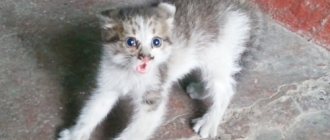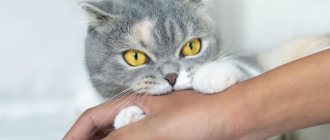With a superficial dive into the topic of the first mating of purebred cats, it seems that everything is simple and uncomplicated. All that is required of the owners is to bring the “groom” and “bride” together, and nature will do everything itself. But professional breeders have a different opinion on this matter, and beginners always have a lot of questions: when is it better to breed, where to do it, how to prepare a pet, what documents need to be drawn up and are they needed at all? I will try to cover the issue in as much detail as possible. Let's start with the most important thing - puberty and then go in order.
What is puberty?
Puberty in a cat occurs earlier than physiological maturity.
This is the stage of development of the reproductive system when a cat has the opportunity to become pregnant, and a cat can fertilize a female. Do not confuse physiological maturity and sexual maturity - the second occurs long before the full growth and development of the body is completed.
In females, sexual maturity occurs at six months of age, but there are cases of the onset of estrus at 4 months. It is logical that the first sexual heat is not a reason to untie the cat. Early pregnancy:
- inhibits growth and development;
- leads to the birth of a weak offspring;
- the period of gestation and childbirth itself is difficult;
- the pet may remain infertile.
One thing is obvious: if the cat is leaking, then it’s time to look for a manufacturer for the future, or better yet two or three, if the main candidate is busy at hour X.
What about cats?
Males become sexually mature at 8 months. During this period, it is quite possible to carry out castration if it was planned, but it is still too early to mate the cat.
Sexual use of the reproducer at such a young age:
- significantly slows down growth and development;
- negatively affects the development of appearance (habitus);
- worsens exterior characteristics;
- may cause impotence.
First mating
The first mating of a cat should be carried out at the age of at least 10 months.
You can breed a cat with a cat after the completion of basic growth and development and the complete formation of the genital organs. Only the fulfillment of these two conditions will make it possible to obtain numerous and full-fledged offspring without damage to the body of the expectant mother.
For cats, the ideal time for the first mating will be 10-15 months of age, but no later than one and a half years. Almost all breeders recommend skipping the first two heats and only then unleashing them.
Important! A cat should not give birth more than 3 times a year.
Late insemination is also undesirable - it can lead to disruption of the reproductive cycle with all the ensuing problems:
- false pregnancy;
- inflammatory processes in the uterus;
- polycystic disease;
- exhaustion;
- stress, etc.
Breeding use of males is permitted after the first year of life.
Time of puberty - how and when it happens
Sexual and physiological maturity of a young kitten occurs between 6 and 9 months of life. An animal can reach maturity two months earlier or later, depending on the breed, conditions of detention, nutrition and characteristics of the body. The time of the first heat is not recommended for mating a cat with a male cat for the first time. During this period, the body continues to actively grow and develop, and a sudden pregnancy can harm the health and well-being of the pet.
© shutterstock
The optimal period to bring a cat together for the first time is the age range from one to one and a half years. At this time, the female will be completely ready to become pregnant and give birth to kittens.
If the cat is titled and takes part in exhibitions, then before breeding it with a cat, it must have a rating of at least “very good”, otherwise breeding animals is not allowed. In the future, according to the rules established for purebred animals, it is necessary to bring a female to a male at least once or twice a year. You can bring an untitled female cat together with a female male during seasonal heat.
Cat mating is a natural and obligatory physiological process that ensures calm behavior, good health and a healthy future for pets.
The estrus period takes several days - usually from 5 to 10. During the first few days the cat behaves restlessly and it will not be possible to calm her down. In the following days, the cat begins to behave more calmly, she takes positions that are convenient for mating. It becomes much easier to match a cat with a cat on the 3-5th day of estrus.
Mating rules for cats
If the owner’s goal is to give birth to high-quality, and most importantly, truly purebred offspring, then he must obtain approval for the choice of a male in the club from professionals.
Now according to the rules themselves:
- You should not use any drugs that affect estrus: hormones are your worst enemy, they lead to the development of serious diseases.
- The cat is looked for in advance through advertisements or at an exhibition, and during breeding - only in the club. If they cannot find a partner, they turn to professional breeders for help.
- By the time of mating (but no more than a year and no later than a month before it), the animal must be vaccinated against rabies, calicivirus, panleukopenia, rhinotracheitis, chlamydia and lichen (the last two vaccinations are not required).
- Two weeks before mating, treatment for worms is carried out.
- On the day of the newlyweds' reunion, both their nails are cut - this will help avoid injury in the event of aggressive behavior.
- You should not bathe your cat before meeting the cat - soap neutralizes the smell of natural pheromones that attract males so much.
In addition, the female must be neat, well-groomed, well-fed, with clean eyes, nose mirror and ears.
When does puberty begin in cats?
For owners of females, the problem of mating their pet becomes relevant already at 6-7 months of their pet’s life: it is at this time that the cat begins her first heat.
Of course, cats should not be mated at this moment, because the animal is still developing (and puberty and physical maturation are not the same thing!), but even then you need to think about future searches for a partner.
The situation is similar for owners of males: cats mature by 7-8 months, but if at this age castration is quite appropriate, then cats do not yet need mating: the animal is not yet ready for it!
If you don't know how old your pet is, the onset of puberty can be determined by certain changes in his behavior.
In cats this manifests itself in:
- the appearance of more characteristic behavior (if previously the kitten was affectionate and gentle, now it may become a little aggressive),
- trying to mark territory,
- attempts to adapt various soft things for their sexual needs.
The signs of maturation in a cat are as follows:
- loud inviting meow,
- changes in gait (during heat, the cat raises its tail and arches its back),
- rolling on the floor
- changes in character - some cats become more aggressive, and some, on the contrary, become affectionate.
As a rule, the first mating of cats should occur at least after the animal is one and a half years old. A female, for example, can be “introduced” to a partner only when she has gone through 2-3 heats, but the ideal age of a cat for mating is one and a half to two years. By this time, the animal will have time to fully develop, and you will have time to give it all the necessary vaccinations.
Remember two rules:
- mating of cats should not be carried out during the first heat, even if it comes late (this can end very unfavorably for the animal!),
- two weeks before mating, the animal should not be given any vaccinations.
We suggest you read: Names and nicknames for German Shepherd boys and girls
Also, you should not delay the mating itself: this can lead to various anomalies (exhaustion of the animal, disruption of the estrus cycle, or even the development of polycystic disease), so it is better to take care of selecting a partner for your pet, regardless of whether you want to do it!
Rules for mating males
- Cat owners must fully control the mating process and monitor their pets.
- You cannot mate two virgins - one of the animals must be experienced in sexual matters in order to avoid psychological and even physical trauma for both.
- The owner of the breeder is fully responsible for the safety of the cat brought to the groom; he must introduce them, give the bride the opportunity to hide if necessary, so that she can get used to the new environment.
- Again, the inseminator must be well-groomed and healthy.
First contact requirements
A partner for a meowing ward is found in advance. They look through advertisements, go to exhibitions, prepare their pet for the decisive meeting.
Rules for mating cats:
- To avoid dangerous pathologies, estrus cannot be stopped with hormonal or other drugs.
- The first mating of cats requires a fully completed vaccination plan (4 weeks must pass after the last immunization).
- Half a month before intercourse, deworming is carried out.
- On the day of the meeting, the “bride” (as well as the “groom”) have their claws trimmed to avoid injury.
- It is wrong to bathe cats before mating: soap and shampoos muffle the smell of pheromones.
- At the crucial hour, they make sure that the female is moderately well-fed, well-groomed, with clean ears, clear eyes, and a shiny nose.
Mating a cat and its conditions:
- The breeder is supposed to be healthy, vaccinated, treated for worms, and externally well-groomed.
- To stimulate sexual activity, it is recommended to enrich the menu with B vitamins a couple of days before intimacy.
- The cat owner, as the owner of the “mating station”, is obliged to ensure that the meeting is successful: organize an acquaintance, competently stimulate the development of sexual relations, and be responsible for the comfort and safety of the furry guest.
The meeting of a pair of virgins is undesirable. It is fraught with psychological or physical damage.
Contractual relationship
This point comes first for owners involved in breeding and selling pedigree animals. It's better to draw up an agreement. The breeders have a sample; the document must include all the mating conditions and the resolution of possible disagreements, which almost always happen.
The contract states:
- Timing of vaccinations for both parents.
- Length of stay of a female in someone else's house.
- Pedigree regalia and achievements of future parents.
- The responsibility of the cat owner to the cat owner, in other words, the groom's side is obliged to return the bride safe and sound.
- Terms of payment for the transaction (cash reward, choice of a kitten or an alternative option for the birth of one baby).
- Conditions for the distribution of kittens to new owners after they reach two months of age.
- Conflict resolution in the event of failure to conceive, the birth of a non-viable offspring, or its death before the age of two months due to some congenital pathology. All possible scenarios are discussed and recorded. This issue can be resolved in different ways: re-knitting for free, return of monetary reward, etc.
In all controversial situations, the owner of a cat may request an additional examination of someone else’s pet in order to prove the “innocence” of his ward in a failed pregnancy or the death of the entire offspring. But it is better to carry out such a check in advance and, in case of doubt, not to enter into a relationship.
A document is a document, but before mating, any of the parties to the contract has the right, and simply the obligation, to collect as much information as possible about the future partner:
- external examination of the applicant for visible defects: poor coat, emaciated appearance, incorrect bite, coloring, etc.;
- study of documents: veterinary passport, pedigree, club card, etc.;
- examination and assessment of previous offspring, if any;
- additional examination by a veterinary specialist who will or will not identify hidden pathology.
All received data must be included in the contract, which will protect you from litigation in the future.
Direct mating
In order not to miss the right moment, it is necessary to observe the cat’s behavior.
You can tell when a cat is in heat by the following signs:
- frequent purring;
- excessive affection or unexpected aggression;
- friction against various objects;
- trembling of the tail and its turning to the side when trying to stroke the animal in the croup area.
It is better to send the female to the cat on the third day after the first symptoms of heat appear. Together with the cat, they provide a toilet, food, dishes, and a carrier.
If the lady is ready to mate, then she herself fawns over the cat, exciting him with her behavior. At the beginning of acquaintance, mutual ignoring of each other, aggression and even fights are possible. At this moment, it is necessary to ensure that the newlyweds do not injure each other.
When understanding has been found in the couple and the owner is confident in future peace, the young people are left alone so that they can reunite in a calm atmosphere. The fact that mounting has occurred is judged by the changed behavior of the female: she does not swear at the cat, she lies down next to him, allowing him to take care of herself in every possible way. And during intercourse, heartbreaking howls can be heard from the room, after which the lady begins to lick herself intensively.
After a while, the man loses interest in his partner and the cat can be taken home, even if the signs of estrus have not completely disappeared. Be sure to inform the owner of the inseminator about the mating results after 3 weeks!
It is clear that the situation described above is an ideal scenario. But in reality, everything does not go so smoothly:
- there are calm ladies, and there are aggressive ones;
- there are impudent ones who suppress the male;
- there are cowards hiding in the corner.
All these moments must be perceived adequately, try to resolve, not force events and give the cat the opportunity to persuade the bride on his own.
How is the mating done?
It is best to schedule a “meeting” between male and female cats on the 3rd-5th day of the cat’s estrus. At this time, mating will be most effective, although in some breeds of cats ovulation may not occur earlier than the 9th day. As a rule, mating takes place on the territory of the cat, where all conditions for mating cats must be provided.
However, the owner of the female will also need to prepare by taking with him:
- pet toilet,
- food and a bowl from which she eats,
- a carrier that the cat is accustomed to - if necessary, the animal can hide in it and rest.
You can recognize a cat’s readiness for mating by its behavior: it begins to flirt with the cat itself, initiating sexual arousal in him. At the same time, when the cat tries to approach, the cat begins to show dissatisfaction, and the male has to recoil and pretend that his partner is not at all interested in him.
This should be repeated several times, but sooner or later the cat will lose vigilance, and then the cat will sit down. If this is the first mating of a cat, and the animal is nervous, its owner should calm it down if possible and make sure that the cat does not cause any injury to the cat.
Mating usually lasts only half a minute and is accompanied by expressive purring from the cat and loud cries from the cat. At this moment, the cat is provoked to release the egg from the ovaries, and then fertilization occurs within 24 hours after mating.
We suggest you read: Treatment of constipation in cats at home: food, medications, suppositories, enemas
Such mating can take place 5-8 times, and this “cycle” usually ends when one of the partners gets tired of it. It should be remembered that one covering may not be enough for a successful mating, and in this case the cat will need to spend 1-2 days with the cat.
You can again recognize the completion of mating by the behavior of the animals:
- After mating, the cat turns over on its back and rolls around,
- After mating, the cat moves away and begins to lick itself.
Unfortunately, just like humans, cats and kittens can also experience incompatibility. Sometimes its manifestations are easily overcome, but there are times when this can lead to additional problems, so you need to initially be prepared for this and know how to help animals if necessary.
Complication No. 1: animals do not match each other in size (the cat is larger than the cat)
In this case, the cat, grasping the female's withers with his teeth, cannot impregnate the cat, because the back of his body rests on her back. In such a situation, the owner must help the cat by grabbing the withers with his hands and giving the male the opportunity to grab the skin below the withers.
Complication No. 2. The cat falls on its side during mating.
In such a situation, mating of cats should occur with the constant support of the owners, who must put the animal in the right position. However, some cats can impregnate cats even if they are lying on their back or side.
Complication No. 3. The cat won't let the cat near.
The most severe case, which most often requires the intervention of a specialist, is the one who must insert a special probe into the cat’s vagina, after which the animal will let the cat in on its own.
In rare cases, patting the cat’s tummy or injecting a drug that induces ovulation can save the situation (the drug for the injection should also be selected by a veterinarian!).
Non-standard situations and their solutions
There are incompatibilities in the cat family. Some are easy to overcome, while others require help or immediate intervention.
- Size discrepancy: the female is larger than the male. The cat is not able to impregnate the cat, since an important part of the body rests on the back of the partner. In such situations, the cat is directed.
- During coitus, a cat falls on its side: a person must support the pet in the correct position, although experienced producers themselves manage to cope with the task in such an awkward position.
- The cat is not given. The case is complicated, and most often you have to retreat and look for another love, since it is the female who decides who will be the father of her future children. If there is an urgent need to obtain offspring from this particular union, experts advise inserting a special probe into the vagina, which provokes ovulation and the female has no choice but to surrender into the clutches of an unloved man. Another way to resolve a similar conflict is to lock the couple in a separate room and hope that love will happen.
- A cat in a new place suddenly loses signs of estrus. It's actually stressful. As soon as the animal gets comfortable, everything will resume. You may have to leave the female to live with the cat's owners for a while so that they become friends and get used to each other.
- The cat is not shedding, but she was brought to the male. There is always the possibility of error when unusual behavior of an animal is mistaken for signs of sexual heat. But you can't fool a cat! If he is indifferent to the opposite sex and does not pay attention to his new life partner, then rest assured that the wedding will not take place.
Advice for owners of expectant mothers and fathers
Rules for keeping males before mating
Before getting a breeding kitten, a future reproducer, answer the following questions:
- Do you need exhibitions and why?
- are you ready to visit them and attract the attention of potential brides;
- Do you have conditions for adopting a cat?
- how will you attract owners of the opposite sex and advertise the groom;
- Can you monitor the health and proper nutrition of the reproducer?
If most of the answers are negative, then it is better to immediately castrate the cat and close the topic of breeding once and for all.
If the answer is yes, you will have to adhere to the rules:
- Do not associate with cats of dubious reputation: those that give birth to sick kittens, defective coloration, suffer from sexually transmitted infections or are involved in inbreeding. All the trouble will fall on the groom, even if he had nothing to do with it.
- Do not overwork the cat: there should be a break of at least a week between matings; periodically they are allowed to rest for a longer period of time. Long downtime is also not welcome. In both cases, the quality of sperm deteriorates, and therefore the quality of the offspring.
- Periodically check and improve the health of the male.
- A few days before planting, introduce B vitamins into the diet, which have a positive effect on sexual function.
Preparation for mating
Before you think about breeding a cat and a cat, you need to make sure that both animals are healthy, as well as conduct a series of medical examinations and receive appropriate vaccinations. Without them, not a single owner will agree to breed. Therefore, you need to go through the following procedures:
- Before mating a cat with a cat for the first time, you need to get all the necessary vaccinations against the most common viruses and infections. The veterinarian will tell you which of them the animal needs. He will also draw up a vaccination schedule, since each of them should be done at a certain time interval. All vaccinations must be included in the cat's passport.
- Conduct a medical examination of the animal. It is very important to find out that your pets do not have any diseases.
- Treat the animal against parasites, both external and internal. Even if the pet is absolutely clean, this must be done as a preventive measure a week before mating.
- Animal owners are required to provide each other with documents confirming the breed of animals (if any).
- Before bringing a cat and a cat together, you need to trim their claws so that unforeseen injuries do not occur during the meeting.
Also obligatory and the most important point in preparing for mating is the cat’s heat. Without it, mating a cat with a cat for the first time is impossible.
Rules for keeping expectant mothers
Requirements are similar to those of males. The owner is obliged:
- provide the animal with adequate nutrition;
- introduce vitamins and microelements, calcium and folic acid are especially important;
- maintain a normal weight for your pet (obese or malnourished animals are unlikely to become pregnant);
- do not overload the body with frequent pregnancies: twice a year is enough;
- monitor exercise: active physical activity will make the cat stronger, and pregnancy and childbirth itself will be easier;
- do not forget about education: only a well-bred mother can instill in kittens the basics of good behavior.
In addition, even before mating, the cat should be assessed by experts who will highlight its advantages, identify disadvantages, check the compatibility of two lines and, based on this data, help find a good sire. If you ignore the rule and do not receive a “ticket to breed,” then the kittens born are unlikely to be recognized as purebred.
In principle, that's all. If you have questions, ask in the comments. Read about what to do after mating and what problems there may be afterwards in the next issue.
Tablets for cats from partying
In addition to drops, tablets are also widely used that can reduce the sexual activity of an animal. However, it is much more difficult to “slip” them to a cat, because he can easily detect them and refuse to eat them. Here the owners have to resort to various tricks and tricks in order to feed the drug to their pet.
If a cat wants a cat, every owner thinks about how to calm him down. The first thing that comes to mind or is recommended by neighbors is to buy tablets at a veterinary pharmacy. They can be divided into sedative and hormonal.
Soothing medications are usually herbal based and require use several times a day. When using these medications, your pet may experience drowsiness, lethargy, and decreased appetite.
As for hormonal drugs, they should be used very carefully and only after undergoing an examination at a veterinary clinic. Otherwise, the animal may experience serious health complications that will require additional treatment or may be life-threatening. Hormonal medications can only be used once a day.
Whatever method you choose, if a cat wants a cat, how to calm him down, you need to think about his health. It is also important to remember that when choosing an option such as castration, natural instincts may not disappear. The cat may continue to try to mark the apartment or yell. This is genetically embedded in him, and it is extremely difficult to overcome these reflexes. The animal will ignore your punishments, or rather, it simply will not understand how to deal with it and what to do, because natural instincts are always stronger.










